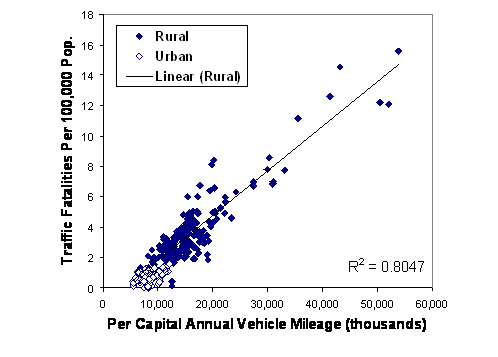Many families move to sprawled, automobile-dependent suburbs because they want a safe place to raise their children. They are mistaken. A smart growth community is actually a much safer and healthier place to live overall.
Many families move to sprawled, automobile-dependent suburbs because they want a safe place to raise their children. They are mistaken. A smart growth community is actually a much safer and healthier place to live overall.
Most discussion of Smart Growth benefits focuses on infrastructure savings, environmental protection, increased accessibility and improved livability. One of the most important benefits, increased traffic safety, is often overlooked. In fact, traffic safety is one of the most important benefits of smart growth and smart growth is one of the most effective ways to reduce traffic risk.
The graph below compares the per capita traffic fatality rate between the ten smartest growth and the ten most sprawled communities, based on the sprawl index developed by Ewing, Schieber and Zegeer. The smart growth communities have about a quarter of the crash fatality rates as the "dumb growth" communities, indicating a huge safety benefit.
Figure 1 Annual Traffic Death Rate (Ewing, Schieber and Zegeer, 2003)

The ten communities with the lowest sprawl rating have about a quarter of the per capita annual traffic fatality rates of the most sprawled communities.
Other indicators also show that crash rates increase with per capita vehicle travel. Figure 2 illustrates this relationship based on Federal Highway Administration mileage and crash data for the urban and rural portions of each of the fifty U.S. states. Deaths increase with mileage.
Figure 2 U.S. Traffic Fatality and Mileage Rates (FHWA 1993-2002 data)

There is a strong positive relationship between per capita annual vehicle-mileage and traffic fatality rates, particularly in rural areas.
On the other hand, there is a negative relationship between annual transit travel and annual traffic fatalities, as indicated in Figure 3. A similar relationship is found with nonmotorized travel, which is a little surprising because walking and cycling have relatively high traffic fatality rates per mile of travel. However, this is offset by reductions in mileage, reductions in the risk to other road users and increased caution by drivers as nonmotorized travel in a community increases. Jacobsen calculates that the number of collisions between motorists and nonmotorists increases at roughly the 0.4 power of the amount of walking and cycling that occurs in a community (e.g., doubling nonmotorized travel increases pedestrian/cycling injuries by 32%), and the probability that a motorist will strike a nonmotorized traveler declines with the roughly -0.6 power of the amount of nonmotorized travel (e.g., risk of a pedestrian being hit by a motorists declines 34% if walking and cycling double in a community).
Figure 3 Transit Use and Traffic Deaths (Litman, 2005)

Per capita traffic fatalities tends to decline with increased transit ridership. These values include deaths to transit passengers, automobile passengers, and pedestrians.
In other words, as people in a community drive less and rely more on alternative modes of travel, overall traffic safety tends to increase significantly. Several factors may contribute to this result. In smart growth communities people drive fewer annual vehicle-miles, traffic tends to be slower so crashes are less severe (urban areas tend to have high total crash rates – there are many fender-benders – but rural areas tend to have much higher fatality rates), and there are better alternatives for higher risk drivers. For example, having grown up in automobile dependent Los Angeles, I had a drivers license and a car when I was 16 years old. Living in multi-modal Victoria, British Columbia, our 18-1/2 year old son has yet to obtain a drivers license because he can get around well without one. As a result, he avoided 2-1/2 years of high-risk driving.
Smart growth and mobility management also reduce pollution emissions and increase physical fitness. For more information on these issues see Frumkin, Frank and Jackson (2004); Frank, Kavage and Litman (2006); and Litman and Fitzroy (2006).
This is very good news overall, because it means that smart growth and mobility management provide even greater benefits than generally recognized, and there are many cost effective strategies that reduce crash risk as well as providing other economic, social and environmental benefits. For example, Pay-As-You-Drive vehicle insurance, road pricing, parking pricing, transit improvements and location efficient development can all help increase traffic safety as well as reducing traffic congestion, road and parking facility costs, consumer costs, energy consumption and pollution emissions.
However, not all traffic safety experts appreciate these ideas. A few years ago, as a contributor to the World Health Organization's 2004 "World Report on Road Traffic Injury Prevention" I was criticized by some team members (particularly those from the U.S.) for suggesting that mobility management should be included among the report's safety strategy recommendations. These experts prefer to measure risk per unit of vehicle travel (per 100 million vehicle-miles or billion vehicle-kilometers) rather than per capita. When measured this way, traffic crashes have declined significantly over the last half-century, implying that current safety programs have been effective and should be continued. However, when measured per capita (per 10,000 residents), crash rates have hardly declined at all during the same period, despite huge increases in seatbelt use, reduced drunk driving, improved vehicle and roadway design, and better emergency response and medical treatments. As a result, although the U.S. has one of the lowest crash fatality rates per vehicle-mile, it has one of the highest rates per capita among OECD countries, indicating that current strategies have failed and new approaches are needed to truly increase traffic safety.
Figure 4 U.S. Traffic Fatalities (BTS, 2000)

This figure illustrates traffic fatality trends over four decades. When measured per vehicle-mile, fatality rates declined significantly, but when measured per capita they show little decline despite efforts to increase safety, due to increased per capita vehicle mileage during this period.
We have a positive story to tell. Smart growth and mobiltiy management are the best way to make a truly safe and healthy home.
References and Information Resources
Reid Ewing, Richard A. Schieber, Charles V. Zegeer (2003), "Urban Sprawl As A Risk Factor In Motor Vehicle Occupant And Pedestrian Fatalities," American Journal of Public Health, Vol. 93, No. 9 (www.ajph.org), Sept. 2003, pp. 1541-1545.
Lawrence Frank, Sarah Kavage and Todd Litman (2006), Promoting Public Health Through Smart Growth: Building Healthier Communities Through Transportation And Land Use Policies, Smart Growth BC (www.smartgrowth.bc.ca); at www.vtpi.org/sgbc_health.pdf.
Howard Frumkin, Lawrence Frank and Richard Jackson (2004), Urban Sprawl and Public Health: Designing, Planning, and Building For Healthier Communities, Island Press (www.islandpress.org).
Peter L. Jacobsen (2003), "Safety In Numbers: More Walkers and Bicyclists, Safer Walking and Bicycling." Injury Prevention (http://ip.bmjjournals.com), Vol. 9, pp. 205-209.
Todd Litman (2004), If Health Matters: Integrating Public Health Objectives into Transportation Decision-Making, Victoria Transport Policy Institute (www.vtpi.org); at www.vtpi.org/health.pdf.
Todd Litman (2005), Rail Transit In Amercia: Comprehensive Evaluation of Benefits, Victoria Transport Policy Institute (www.vtpi.org); at www.vtpi.org/railben.pdf.
Todd Litman and Steven Fitzroy (2006), Safe Travels: Evaluating Mobility Management Traffic Safety Benefits, Victoria Transport Policy Institute (www.vtpi.org); at www.vtpi.org/safetrav.pdf.
William Lucy (2002), Danger in Exurbia: Outer Suburbs More Dangerous Than Cities, University of Virginia (www.virginia.edu); summarized in www.virginia.edu/topnews/releases2002/lucy-april-30-2002.html.
Sprawl and Health (http://cascadiascorecard.typepad.com/sprawl_and_health) is an ongoing literature review by researchers at Northwest Environment Watch on the intersection of sprawl and health.
WHO (2004), World Report on Road Traffic Injury Prevention, World Health Organization and World Bank (www.who.int); available at www.who.int/entity/world-health-day/2004/infomaterials/world_report.

Planetizen Federal Action Tracker
A weekly monitor of how Trump’s orders and actions are impacting planners and planning in America.

Chicago’s Ghost Rails
Just beneath the surface of the modern city lie the remnants of its expansive early 20th-century streetcar system.

Amtrak Cutting Jobs, Funding to High-Speed Rail
The agency plans to cut 10 percent of its workforce and has confirmed it will not fund new high-speed rail projects.

Ohio Forces Data Centers to Prepay for Power
Utilities are calling on states to hold data center operators responsible for new energy demands to prevent leaving consumers on the hook for their bills.

MARTA CEO Steps Down Amid Citizenship Concerns
MARTA’s board announced Thursday that its chief, who is from Canada, is resigning due to questions about his immigration status.

Silicon Valley ‘Bike Superhighway’ Awarded $14M State Grant
A Caltrans grant brings the 10-mile Central Bikeway project connecting Santa Clara and East San Jose closer to fruition.
Urban Design for Planners 1: Software Tools
This six-course series explores essential urban design concepts using open source software and equips planners with the tools they need to participate fully in the urban design process.
Planning for Universal Design
Learn the tools for implementing Universal Design in planning regulations.
Caltrans
City of Fort Worth
Mpact (founded as Rail~Volution)
City of Camden Redevelopment Agency
City of Astoria
City of Portland
City of Laramie






























